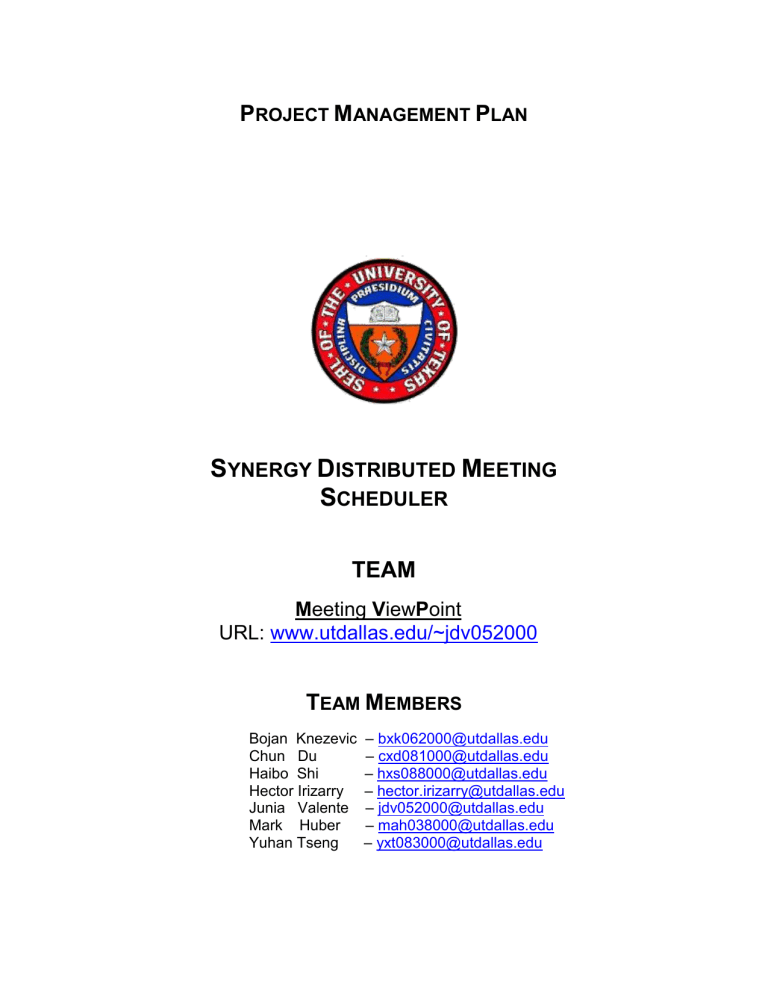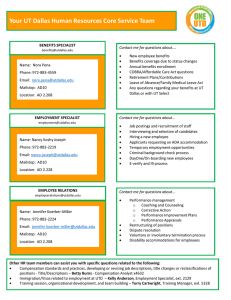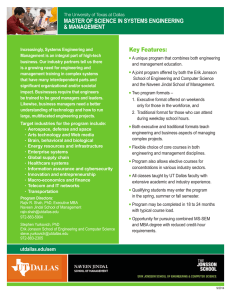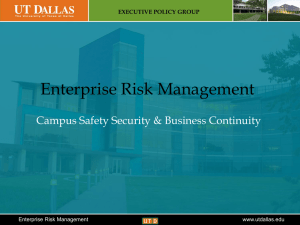
PROJECT MANAGEMENT PLAN SYNERGY DISTRIBUTED MEETING SCHEDULER TEAM Meeting ViewPoint URL: www.utdallas.edu/~jdv052000 TEAM MEMBERS Bojan Knezevic Chun Du Haibo Shi Hector Irizarry Junia Valente Mark Huber Yuhan Tseng – bxk062000@utdallas.edu – cxd081000@utdallas.edu – hxs088000@utdallas.edu – hector.irizarry@utdallas.edu – jdv052000@utdallas.edu – mah038000@utdallas.edu – yxt083000@utdallas.edu Project Management Plan Revision History Author Date Description Version Team 08/31/2008 Initial version of the project plan document 1.0 Team 09/03/2008 Cover page and table of contents added 1.1 231215968 (01/28/22) Page 1 Project Management Plan CONTENTS 1.1 1.2 1.3 1.4 1.5 PROJECT OVERVIEW ................................................................................................3 PROJECT DELIVERABLES..........................................................................................3 EVOLUTION OF THIS DOCUMENT ..............................................................................4 REFERENCES ...........................................................................................................4 DEFINITIONS, ACRONYMS AND ABBREVIATIONS.......................................................4 2. PROJECT ORGANIZATION .......................................................................................6 2.1 2.2 2.3 2.4 PROCESS MODEL .....................................................................................................6 ORGANIZATIONAL STRUCTURE ................................................................................6 ORGANIZATIONAL BOUNDARIES AND INTERFACES...................................................6 PROJECT RESPONSIBILITIES ....................................................................................6 3. MANAGERIAL PROCESS ...........................................................................................7 3.1 3.2 3.3 3.4 MANAGEMENT OBJECTIVES AND PRIORITIES ...........................................................7 ASSUMPTIONS, DEPENDENCIES AND CONSTRAINTS ................................................7 RISK MANAGEMENT ..................................................................................................7 MONITORING AND CONTROLLING MECHANISMS .......................................................8 4. TECHNICAL PROCESS ..............................................................................................9 4.1 4.2 4.3 METHODS, TOOLS, AND TECHNIQUES ......................................................................9 SOFTWARE DOCUMENTATION ..................................................................................9 PROJECT SUPPORT FUNCTIONS ...............................................................................9 5. WORK ELEMENTS, SCHEDULE AND BUDGET .........................................................10 231215968 (01/28/22) Page 2 Project Management Plan 1. INTRODUCTION 1.1 Project overview This project is part of a contract with Synergy Inc. to support the Synergy Distributed Meeting Scheduler (SDMS) program. The SDMS is a Synergy Inc. effort to gain a share of the COTS meeting scheduler products market. The primary goal of the SDMS project is to support people to schedule their meetings. SDMS aims to keep the user interaction minimal by automating the process as much as possible therefore increasing the user’s organization productivity. The high-level functionalities of the system are: Plan meetings Monitor meetings Support conflict resolution Maintain user information Keep users informed of meetings This project consists in two phases. The first phase requirement elicitation is that we are to deliver a detail requirement description and a non-functional prototype of the GUI. As for the second phase, product specification and process specification, the specific details concerning the deliverable, are still to be determined but a functional prototype is required. 1.2 Project deliverables Phase Deliverable Preliminary Project Plan 1 Interim Report Final Report Mockup Interim Report Final Report 2 Final Project Plan Traceability Matrix between phase 1 and 2 Project with basic functions 231215968 (01/28/22) Page 3 Project Management Plan 1.3 Evolution of this document This document will be updated as the project progresses. A new revision will be released after each modification. Every modification has to be logged in the Document Revision History. Each log entry must include date, revision identifier, author’s name and brief description of the modification. The author of the modifications is responsible for updating the Document Revision History. Updates should be expected in the following sections: a. References – will be updated as necessary. b. Definitions, acronyms, and abbreviations – will be updated as necessary. c. Organizational Structure – will be updated as the roles and responsibilities are assigned for each phase. d. Management objectives and priorities – will be updated to as priorities change. e. Assumptions, dependencies and constraints – will be updated as necessary. f. Risk management – will be updated as new risks are identified. g. Technical Process – will be updated as requirements become clearer. h. Work elements, schedule and budget – will be updated in the case of schedule or budget changes. 1.4 References [1] http://www.utdallas.edu/~chung/RE/syllabus.htm [2] http://www.utdallas.edu/~chung/RE/Project1.pdf [3] http://www.ibm.com/developerworks/rational/library/769.html [4]http://www.utdallas.edu/~chung/CS6354/CS6354_U07_source/Team_2/SoftwareProjectManagem ent_Plan_v1.1_Team2.doc [5] http://re-project.org/Documents/Final_Project_Plan.doc 1.5 Definitions, acronyms and abbreviations active participant A user, who is an attendee that may also be asked provide requirements for equipment. administrator Is a privileged user who is responsible for managing user accounts, and managing resources (ex. adding or removing users, rooms, etc). attendee A user, who receives a meeting invite, and is responsible for either accepting or declining the invite. In the case the invite is accepted, the attendee is required to provide an exclusion and preference set. An attendee can be furthermore classified as important or active participant. concurrency The ability to handle more than one meeting requests at same time. confirmation An e-mail notification sent to attendees by the initiator confirming the final meeting. COTS Commercial of- the-shelf. A software product that is ready-made and available for sale. customer Synergy Soft Inc. 231215968 (01/28/22) Page 4 Project Management Plan date conflict Occurs when no date can be found in the stated date range. date range Time interval prescribed by the initiator that set the boundaries for the exclusion and preference sets. date set A pair of input, including calendar date and time period. end customer Person, or organization, that buys the SDMS software. exclusion set A set of dates on which the attendees cannot attend the meeting. GUI: Graphical User Interface. important participant: A user, who is an attendee that may also be asked provide meeting location preferences. initiator: A user, who calls for the meeting. The initiator is responsible for performing the meeting scheduling activities or to delegate an initiator representative to perform them on his behalf. initiator representative A user who is delegated to act on behalf on initiator. invite Is a meeting request sent by initiator or representative to the potential attendees, which includes meeting topic, date range and it requires attendees to respond with their preferences regarding date. For active participants the invite will require the attendee to provide equipment requirements. For important participants the invite will require the attendee to provide location preferences. meeting scheduling activities Tasks required to schedule a meeting. Usually involve the following tasks: planning the meeting, sending the Invites, monitoring the responses, resolving conflicts, and confirming the final arrangements. nomadicity The ability to move from one location to another and start communications. preference set A set of dates on which the attendees would prefer the meeting to take place. private meeting A meeting that concerns only to the user. professional meeting A meeting that concerns to the user’s organization. SDMS Synergy Distributed Meeting Scheduler strong conflict No date can be found within the date range and outside all exclusion sets. UML Unified Modeling Language user Person who interact directly with the product. weak conflict A dates can be found within the date range and outside all exclusion sets, but no date can be found at the intersection of all preference sets. virtual location Corresponds to a non –physical location where the meeting could take place (e.g. teleconferencing). 231215968 (01/28/22) Page 5 Project Management Plan 2. PROJECT ORGANIZATION 2.1 Process model The SDMS will be developed under waterfall process model. This model encompasses the following activities: system engineering, requirement analysis, software design, implementation, and testing. The requirement analysis will be highly emphasized. After the software design phase, a mockup will be built to show the functions and operations of the product. Later, an executable product with primary functions will be implemented. 2.2 Organizational structure The team consists of 7 members, and each member will be involved in a sub-phase of the project as a team leader. Team Leaders Sub-phase Haibo Shi 1 Hector Irizarry 2 Bojan Knezevic 3 Mark Huber 4 Chun Du 4 Yuhan Tseng 3 Junia Valente 2 2.3 Organizational boundaries and interfaces For each subphase, there will be two team leaders in the team. The rests are common members. In order to give leadership experience to every member, the team leaders will change in different subphases. 2.4 Project responsibilities The team leaders are responsible for arranging and coordinating the tasks of each team members, integrating every members work and submitting the deliverables. Team members should work on their tasks decided by team discussion. 231215968 (01/28/22) Page 6 Project Management Plan 3. MANAGERIAL PROCESS 3.1 Management objectives and priorities The objective of the project is to develop a meeting scheduler product through an organized routine which allows us to concentrate on core elements at different phases more easily and efficiently. The primary focus of our team is the reliability, usability, and quality. Satisfying requirements and perfecting the product is very important to us. Meeting user's needs is our top goal. 3.2 Assumptions, dependencies and constraints It is assumed that every team member has basic knowledge of Programming, Software Engineering, and Database. 3.3 Risk management Risk Unavailable resource Team member absence Unfamiliar with technique Reuse Lack of communication 231215968 (01/28/22) Possibility Low Medium High High High Impact Description Solution Medium Unavailability of certain resource, including google doc/group, internet and etc All important document and message are sent to email accounts. Medium Team member is unable to come to team meetings. Do regular knowledge backup. Share knowledge of everyone’s work to the whole team. High Team member is not familiar with tools or techniques used in this project. Do team tutorial, selflearning. Evaluate team member skills before each phase and/or re-assign team roles. Medium Team is not able to reuse code and/or documentation. Only reuse if parts are well understood, otherwise create it from scratch. High Team members fail to communicate at critical times Be active and effective in communication, monitor team member response and project involvement. Provide friendly environment. Page 7 Project Management Plan 3.4 Monitoring and controlling mechanisms Each subphase will have a team leader. This person will deliver a work schedule with weekly goals at the beginning of each subphase. Weekly meetings will be set up to review key components at current stage. Team leader is responsible to establish a record to trace the modifications made during the meeting. Further discussions will be made between meetings through online group (google group). Documentation will also be updated after each meeting. Team leader can adjust the weekly goals by checking the progress of each subphase to ensure the subphase will meet the requirements and be deliverable on time. 231215968 (01/28/22) Page 8 Project Management Plan 4. TECHNICAL PROCESS 4.1 Methods, tools, and techniques Client techniques and tools: JSP, Html, Javascript Server techniques and tools: Servlet, Tomcat Database: MySQL 4.2 Software documentation UML Documentation: Rational Rose Project Documents: Microsoft Office 4.3 Project support functions Document Collaboration: Google Docs (Beta) Online Team Collaboration: Google Groups 231215968 (01/28/22) Page 9 Project Management Plan 5. WORK ELEMENTS, SCHEDULE AND BUDGET Deliverable Due Date Preliminary Project Plan Sep 4, 2008 Phase 1 Interim Report Oct 2, 2008 Phase 1 Final Report Oct 23, 2008 Mockup Oct 23, 2008 Phase 2 Interim Report Nov 13, 2008 Phase 2 Final Report Dec 4, 2008 Final Project Plan Dec 4, 2008 Traceability Matrix between Phase 1 and 2 Dec 4, 2008 Project with basic functions Dec 4, 2008 231215968 (01/28/22) Page 10


